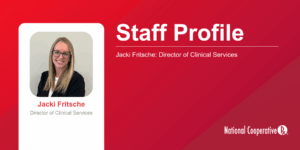- 0.5x
- 0.8x
- 1x
- 1.2x
- 1.5x
- 2x
In our conversations with members and partners, we often hear similar questions about industry buzzwords. In this blog, we explore common pharmacy benefit buzzwords and share National CooperativeRx’s approach to each.
Transparency
Transparency is one of the most frequently used—and often misused—terms in the pharmacy benefit management industry. Although many pharmacy benefit managers (PBMs) claim to be transparent, questions about contract ownership or pricing often reveal withheld details, like undisclosed private equity ownership or hidden secondary agreements.
At National CooperativeRx, all member-owners sign directly onto a single, fully accessible master contract that discloses the complete financial arrangement. We also engage third-party auditors to review 100% of claims at no added cost to members, thoroughly examining pricing, dispensing fees, rebates, and guarantees. All audit recoveries, discounts, rebates, and net earnings are passed through to our members—ensuring that 100% of the value is returned to where it belongs.
Fiduciary Duty
The Employee Retirement Income Security Act of 1974 requires plan fiduciaries to act in the best interests of the plan and its participants. The Consolidated Appropriations Act of 2021 builds on this by requiring greater transparency around pharmacy benefit costs and service provider compensation, ensuring they are reasonable and free of conflicts of interest.
While PBMs cannot absolve plan sponsors of their fiduciary obligations, many plan sponsors seek support in demonstrating compliance.
At National CooperativeRx, we perform many functions that support plan sponsors’ fiduciary duties and equip them with information that can help exhibit their due diligence in providing a robust, cost-effective pharmacy benefit. Our Demonstrating Fiduciary Duty Compliance Document outlines key areas of our support—including our PBM request for proposal process, ongoing oversight, active management strategies, and more. This document is available to members and partners on our Member Resources webpage or by request.
Trend
Trend reflects changes in pharmacy spend driven by rising drug prices, shifts in utilization, and the emergence of new therapies. High trend can jeopardize plan sustainability, which is why members and partners often monitor trend data to evaluate performance.
At National CooperativeRx, we proudly report our average cost per plan participant each year along with our trend data. Our metrics account for all members and all prescription drug spend flowing through our purchasing arrangement. While industry reports projected trend increases between 8-12% in 2024, National CooperativeRx achieved an overall trend of just 5.6%, after rebates.
GLP-1s
GLP-1s are one of the fastest-growing categories in pharmacy spend due to their effectiveness for weight loss. Members and partners frequently ask the same question: what GLP-1 management strategies do you offer?
At National CooperativeRx, we work closely with members and partners to explore options that balance their clinical needs with cost containment. Those interested in GLP-1 management can choose CVS Caremark’s featured strategy or National CooperativeRx’s custom strategy, which can be used alone or alongside CVS Caremark’s point solution management offerings. Our custom strategy requires a type 2 diabetes diagnosis and focuses on minimizing off-label use while enforcing plan intent.
GLP-1 trend comparisons from 2023 to 2024 show approximately a 40% trend with no management strategy, 20% with CVS Caremark’s featured strategy, and only 10% with National CooperativeRx’s custom strategy.
Specialty
Specialty drugs remain a pressing topic due to their large share of overall pharmacy spend. Members and partners often ask about strategies for managing these high-cost medications.
At National CooperativeRx, we support our members with customized clinical strategies to manage specialty drug costs without compromising quality of care. Our Cooperative-led clinical programs include supplemental formulary management, high-cost claim reviews, and in-house specialty prior authorization—all provided at no additional cost. Our clinicians proactively monitor the specialty pharmacy pipeline using subscription-based tools and other resources to identify emerging therapies and relevant clinical trials, assess their clinical value and trend impact, and tailor recommendations to the unique needs of our members.
These efforts contributed to an estimated $60 million in cost avoidance for our membership in 2024, which helped National CooperativeRx achieve a notably low specialty drug trend of just 2.5% last year.
Biosimilars
Biosimilars are lower cost, clinically equivalent alternatives to high-cost biologic medications. As more biosimilars enter the market, members and partners are eager to understand how we are leveraging these alternatives to help reduce specialty drug spend.
In April 2024, our PBM Partner, CVS Caremark, removed brand Humira from its most widely used formulary and began preferring select biosimilars. National CooperativeRx members swiftly transitioned to these lower-cost options, resulting in nearly $9 million in savings from 2023 to 2024 for our membership.
Cell and Gene Therapies
Cell and gene therapies are among the most advanced and rapidly evolving treatments in healthcare, with some costing as much as $4.25 million for a single dose.¹ While the FDA has only approved 45 of these therapies, more than 4,000 are currently in development. As more therapies come to the market, the potential for a major financial impact on pharmacy plans becomes more likely—prompting members and partners to ask how we are managing this risk.
At National CooperativeRx, our clinical team actively monitors the cell and gene therapy pipeline and assesses potential impact. Given their complex handling and administration requirements, we recommend managing these therapies under the medical benefit. Our no-additional-cost, in-house clinical programs can be employed to help redirect these therapies to the medical benefit where more appropriate utilization management can be applied.
Conclusion
The pharmacy benefit landscape is constantly evolving with new buzzwords, trends, and challenges. At National CooperativeRx, we are industry experts dedicated to helping members and partners confidently navigate today’s complexities and tomorrow’s uncertainties.
Want to learn more about how we are addressing pharmacy benefit trends? Contact us today.
Sources
- Fraiser Kansteiner et al. (2023, May 22). Most expensive drugs in the US in 2023. Fierce Pharma. https://www.fiercepharma.com/special-reports/priciest-drugs-2023




